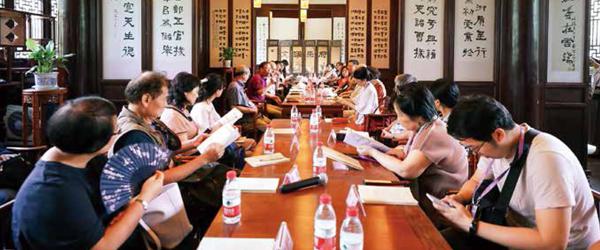茶瓷有缘,且看文化连枝——情系钱塘
陈淡宁
“情系钱塘——两岸文化联谊行”活动开幕式近日在杭州举行。百余位两岸文化、教育、新闻等领域的嘉宾出席了开幕式。
本次“情系钱塘——两岸文化联谊行”活动为期8天,安排台湾嘉宾赴杭州、乌镇、宁波、衢州、开化等地考察文化遗产、参观文博机构,观摩优秀剧目和非物质文化遗产展示,同时参加“文化浙江”推介会、乌镇城市文化沙龙、文化合作交流座谈等特色活动。
“情系中华——两岸文化联谊行”是中华文化联谊会于2001年开展的两岸文化交流活动,邀请台湾地区具有较高艺术造诣和社会影响的文化、教育、新闻等领域知名人士,文化机构、艺术团体负责人及大陆文化人士参加,至2017年已与有关省、自治区人民政府合作,成功举办了15届。
博物馆已经进入4.0阶段
活动开幕当天,83位台湾嘉宾与20余位浙江本地文化艺术界代表一行,分三路参观了中国丝绸博物馆、浙江省博物馆、中国美术学院、浙江音乐学院、杭州创意设计中心、西泠印社、中国印学博物馆等杭城知名的文化地标。对于杭州充满历史感的文化建筑,台湾嘉宾表现出了浓厚的兴趣。
在文澜阁,四库全书“抗战六迁”的故事,让嘉宾们听得津津有味;
传承百年依然人丁兴旺的西泠印社,令台湾嘉宾赞叹不已;
中国美院民艺馆里的皮影和民间刺绣,浙江音乐学院里浙江越剧团的越剧清唱,也让嘉宾们一饱眼福与耳福。
台湾嘉宾代表团团长、铭传大学讲座教授洪孟启在开幕式致辞中,用庄子“藏天下于天下”的名句,诠释了文化交流的意义:唯有不藏,方能不失。
对于“不藏”,在场的一些台湾嘉宾是深有体会的。对他们来说,此行是一场久别重逢。比如台北故宫博物院专门委员陆仲雁。许多读者应该记得,2011年浙江博物馆拿出馆藏珍宝黄公望的《富春山居图(剩山图)》,与台北故宫博物院所藏《富春山居图(无用师卷)》合璧,让《富春山居图》重新以完整面貌示人,陆仲雁正是这场合璧的见证人之一。当时为期两个月的展览轰动一时,吸引了50余万参观者。也因此,时隔7年后,当陆仲雁见到浙江博物馆副馆长蔡琴,谈及当年盛况时仍兴奋不已。
此次来浙,陆仲雁的主要考察方向就是浙江的各大博物馆:“我非常高兴,这次看到了很多博物馆的发展进入了AI时代。我们常常讲,现在已经进入到博物馆4.0阶段,而这个4.0就结合了科技、数字的内容在里面。”
给陆仲雁留下深刻印象的是位于衢州的中国儒学馆:“它是一个比较新的博物馆。我们通常进入一个博物馆,是先进入它的建筑,然后再看到建筑里硬体的展陈模式,接下来再注意到研究内容,以及数字化的设备技术。在这个展厅里,我看到了很多的小孩子,有一个7岁的小女生很亲切地接待我们。以参观者的角度来看,這种祖父母、父母带着孩子们透过数字化的荧幕、通过互动式的参观和纪念,正呼应当下我们关注的传统与现代的结合。”在台北故宫工作了11年的陆仲雁表示,台北故宫博物院有一个特别的科室专门负责博物馆资源的数字化发展,近年来也获得了不少国际奖项。而这次参访,让她看到了大陆博物馆对于传统的重视,看到最新的科技如何与传统结合:“这样让参观的人能够有更多的参观经验,让文化扎根,是非常值得推崇借鉴的。”
我们是茶瓷始创者
不光是博物馆,为期8天的参访过程中,浙台两地嘉宾还就丝茶瓷文化、传统戏剧以及文创产业趋势等展开了热烈的探讨,形成了许多共识。双方都认为浙江与台湾有很多相似之处,在文化方面更是有许多同气连枝的地方。
比如两地都是茶、瓷文化发达的地区。台北市文化艺术促进协会执行长黄寤兰女士表示,在来浙之前,经常听到许多台湾的茶文化专家对杭州、对浙江赞不绝口。此次访问更给了她直观的感受,从物质生活到精神享受,在这里的每分每秒都能引起她对宋朝的美好想象。也因此,黄寤兰认为,在茶瓷文化方面,浙江是可以拿下主动权的:“现在一提茶道人们就想到日本,一讲青瓷就说高丽。但其实这些东西的根都是我们浙江、杭州的官窑文化。我们有太多精美的东西,全世界都无法企及。也正是由于有太多精美的东西,反而无法做到一一重视。但我相信我们是可以把这些旁落在外的文化重新拿回来,让世界知道,我们才是始创者。”
再比如两地的文创产业都发展得如火如荼。
台湾知名诗人罗智成,是此次台湾代表团的副团长。
在他看来,两岸的文创产业虽然都发展得很红火,但同时也都面临着需要突破的瓶颈,很多文创依然停留在30年前的水准,而另一些所谓的文创,还处在“学生交出一份习作让老师评分”的阶段。而突破这个瓶颈的钥匙,罗智成认为是“对生活的想象力”,因此“艺术家不可替代。现代社会有太多的人在提市场导向,在做市场调查。但过度地关注市场,很容易问道于盲。事实上,好的创作是会启发市场的。”罗智成说,“而联结艺术与工业之间的那个重要的一环,就是生活方式。”
8天的参访让罗智成诗兴大发,他专门为杭州写下了一首诗:
我被触动的灵魂迷路了
秘密和诸神灵有了盟约
彻夜不返
在被星空冻结的荷塘
和共同沦落天涯的刺史
狂歌天长地久的遗憾
和出来散心的女鬼
吟咏阴森缱绻的篇章
和高处不胜寒的通判
讨论那次最美的流放
和悲欣交集的僧人
攀谈前世今生的无常
罗智成说杭州在他心里已经有了情结。这种情结不单单是因为这里旖旎的山水风光与深厚的文化底蕴,还因为这座城市里有这样的一种生活方式:你可以在一间富有设计感的服装店里坐下饮茶,甚至能在店里买到有机食品,而这座城市对于这样看似“不专注”的店,充满了包容与理解,甚至还给予了它继续生长的空间。
“杭州很熱爱生活。”笔者说。
“不,是生活很热爱杭州。”诗人罗智成说。
(本文图片由马崇炎、丁俊豪、王一波摄)
August 15th, 2018 witnessed the launching of “Emotional Ties with Qiantang”, a culture-centered tour through Zhejiang for friends on both sides of Taiwan Strait.
The annual event was initiated in 2001. People in the circles of education, culture, and news media of Taiwan and their counterparts on the mainland are invited to take a tour. The year 2018 marks the 16th tour. This year, the tour lasted 8 days. The group this year was made up of 83 guests from Taiwan and twenty plus from Zhejiang.
The itinerant included Hangzhou, Wuzhen, Ningbo, Quzhou and Kaihua. The guests visited museums and galleries, watched opera plays, attended workshops on cultural exchanges and cooperation across the Strait.
The biggest number of activities happened on the launching day in Hangzhou. The 100 plus guests were divided into three groups and respectively visited cultural landmarks in the city such as China National Silk Museum, Zhejiang Museum, China Academy of Art, Zhejiang Conservatory of Music, Hangzhou Innovative Design Center, Xiling Seal Art Society, and China Seal Art Museum. At Wenlange Library, one of the seven libraries built under the imperial decree in 1782 to hold a complete collection of , the guests attended a lecture and learned how the library moved all the books six times during World War II to prevent the treasure collection from being snatched by Japanese invaders.
Lu Zhongyan, a senior official at the Palace Museum in Taipei, witnessed the joint exhibition in Taipei in 2011 of the two parts of by Huang Gongwang of the Yuan Dynasty. The two parts of the masterpiece are respectively in the collections of Zhejiang Museum and the Palace Museum in Taipei. The exhibition lasted 2 months and attracted over 500,000 visitors. Lu was excited to meet Cai Qin, vice director of Zhejiang Museum who was instrumental in making the exhibition happen in 2011. The two women held hands and took a photo to honor the reunion. On this tour in August 2018, Lu Zhongyan wanted to visit major museums in Zhejiang. “The museums in Zhejiang have entered the 4.0 era featuring Artificial Intelligence,” remarked Lu.
Lu was deeply impressed with the Confucianism Museum in Quzhou in southwestern Zhejiang. The guests were received by a 7-year-old girl. The museum now uses digital devices to help visitors see more and learn more. Lu said that the Palace Museum in Taipei now has a special department dedicated to digitalization and the prestigious museum has won many international awards for the effort. She said this visit to Zhejiang opened her eyes to the new efforts made by her counterparts on the mainland to promote traditional culture through cutting-edge technology
During the 8-day tour, the guests from the two sides of the Strait had discussions and came to many consensuses. The guests agreed that Zhejiang and Taiwan have a lot in common. Both are known for tea and pottery. Huang Wulan, executive director of the Taipei Association for Promotion of Culture and Art, said she had heard a lot from tea culture experts in Taiwan about Hangzhou and Zhejiang and this tour confirmed what they had said. “When it comes to the tea ceremony, many people would say Japan and when it comes to porcelain, many people would point to Korea. But the roots of tea and porcelain are in Zhejiang. We have a responsibility to let the world know that tea and porcelain originated in China,” emphasized Huang.
Luo Zhicheng, a prominent poet in Taiwan, served as vice leader of the visitor group from Taiwan. He said that though the cultural industries on the both sides were flourishing, there were bottlenecks to be broken. In his eyes, some cultural products were backward, not better than those created 30 years ago and some were as immature as a students homework just handed in for a teachers grading. The key to making a breakthrough is “the imagination toward life”, according to Luo. “Artists are irreplaceable. There are too many people talking about market orientation and looking into market. Excessive attention to market can mislead. Good artworks inspire market. The link between art and industry is the way of life,” argued the poet.
Luo talked about his Hangzhou complex. His emotional bond with Hangzhou is more than due to the citys culture and natural beauty. The attraction is the citys way of life. One can sit down for a cup of tea in a fashion shop and can even buy some organic food there. The city tolerates such shops that seem a little bit “unfocused” and gives room for these shops to survive and grow. One explanation to such a way of life is that Hangzhou has a passion for life, but Luo disagreed. “Life has a passion for Hangzhou,” the poet provided another perspective.

